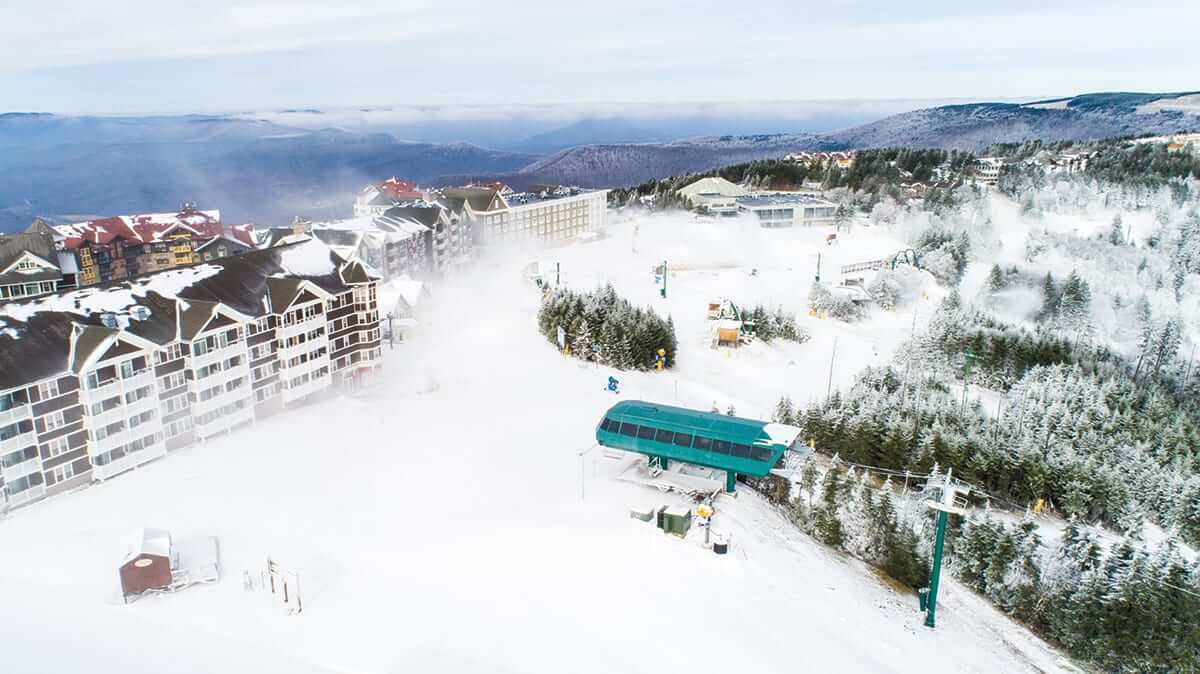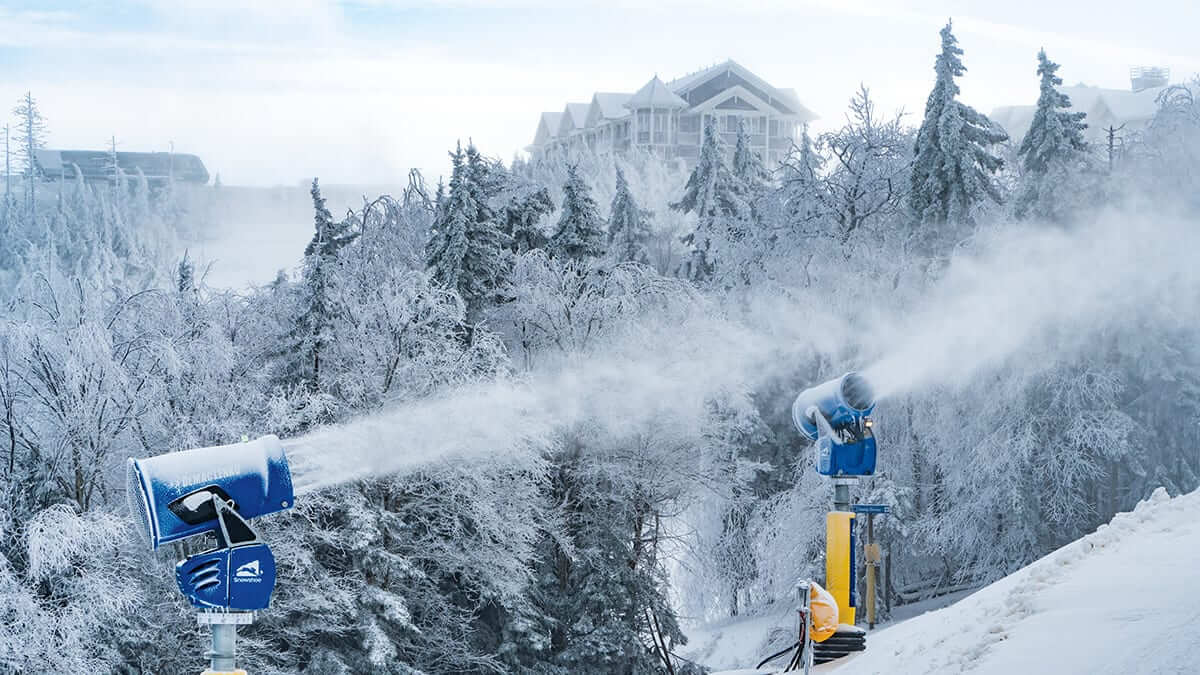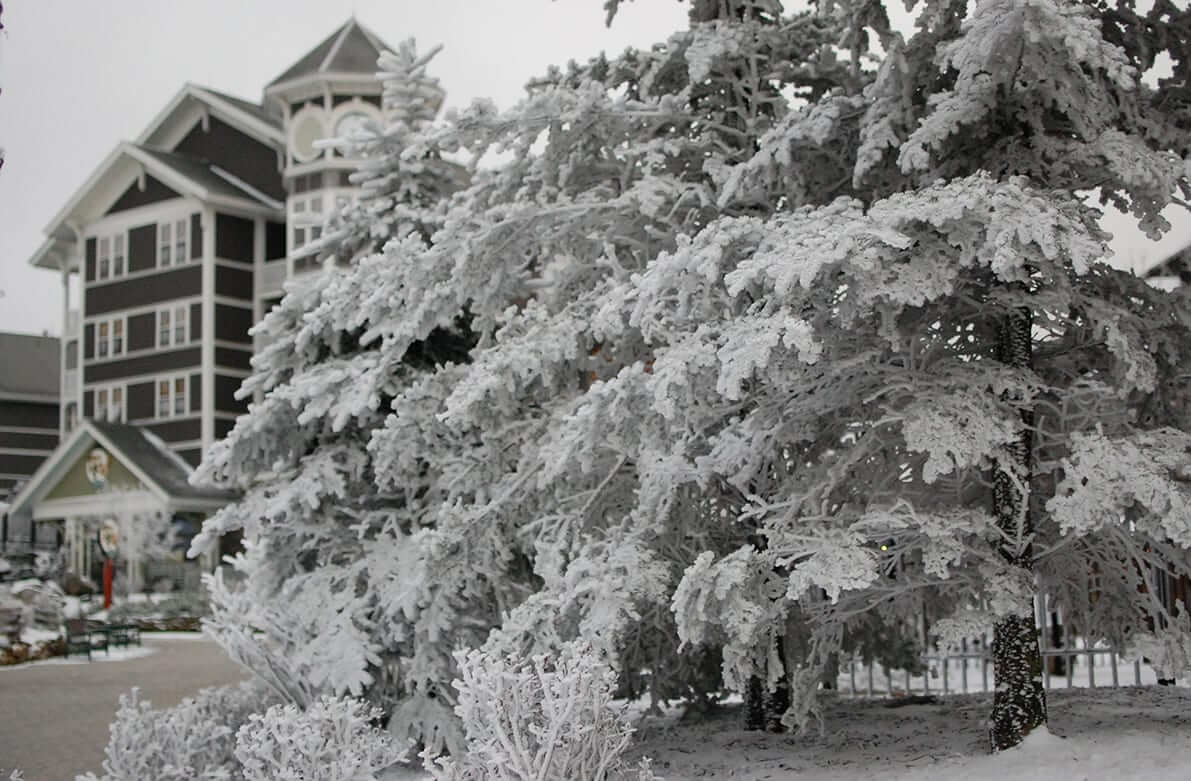How Snowshoe Mountain Resort makes every winter a snowy one.
The powdery slopes of Snowshoe Mountain Resort seem like a wonder of natural beauty. Unfortunately, the Mid-Atlantic—with its relatively mild winters, relatively low elevations, and high humidity—isn’t naturally a skier’s paradise. Without the science of snowmaking, Snowshoe wouldn’t exist. And snowmaking wouldn’t be possible without snowmakers.
The job would have most of us running for a warm fire and mug of hot chocolate, but snowmakers are a different breed. Snowshoe’s snowmaking manager, Ty Tegtmeyer, spent more than two decades in sunny Florida before joining the team in 2008. But the cold has never bothered him. Tegtmeyer has a background in landscaping and says the job is just like dealing with snow instead of dirt. Except, of course, a landscaper doesn’t have to wait for the temperature to dip below 28 degrees to begin working.
With Mother Nature in charge, every day provides a new challenge. The satisfaction of defying her never gets old, though. “When she says we can’t open, we go ahead and open,” says expert snowmaker Bill Jones. He started working at the Silver Creek Ski Resort after high school in the 1980s. The resort merged with Snowshoe in the 1990s and now, with more than three decades of winters under his belt, Jones still has a passion for making it snow.
How Snow is Made
There is nothing artificial about man-made snow. All tiny crystals of frozen water are considered snowflakes. The difference is in production.
Nature creates snow through water vapor in clouds. Pure water wouldn’t be able to freeze at 32 degrees Fahrenheit, but the water vapor can, due to nucleators––tiny, naturally-occuring material like dirt and bacteria. Water molecules gather around a nucleator to form an ice crystal. That crystal collects more and more crystals until it becomes a snowflake. Eventually, the crystals grow too heavy for the atmosphere to keep aloft, and they fall. If the temperature is warm, these crystals melt into rain. In colder temperatures, they stay frozen and become snow.
Man’s recipe for snowmaking magic has two ingredients: electricity and water. During the winter, snow “guns” are positioned across a ski resort. These guns push out compressed air—some through an air hose and others with fans. That air hits chilly, high-pressure water pumped from another hose. “Imagine a gallon of milk and stack 7,000 of them on top of one another,” Tegtmeyer says. “We’re pumping that every minute.”
When air hits water, the water shatters into tiny droplets, which the compressed air cools before it falls to the ground. Snowmakers often mix the water with a nucleating agent, usually a natural protein called Snomax, to help it freeze faster.
Snowshoe pumps its water from the Snowshoe basin so that, when the snow melts in the spring, it runs off the mountain and back into the lake.
Working with Snow
Snowmakers measure snow quality on a scale of one to nine. One is akin to powdery chalk dust; nine is snow so wet that it drips. Before ski season begins, snowmakers use wetter snow to establish a base layer. They don’t create the dry, silky stuff until skiers are ready to hit the slopes.
Control of texture often comes from adding or subtracting water from the gun. Older style guns require snowmakers to walk into the newly minted snow to physically assess it. Newer guns are automated to calculate how much water the gun can handle at any given time.
Manufactured snow is easier to work with than natural snow. It packs together better and sticks around longer, which is ideal for a long ski season. In the winter, Snowshoe’s 25-person crew runs on twelve-hour shifts to ensure round-the-clock coverage. Snowcats—lightly built bulldozers with tank-like tracks—prowl throughout the night to smooth piles, cut away any ice, and leave trails looking brand-new by morning.
Snowmaking carries inherent dangers with it. Unlike the quiet flakes that fall from the sky, man-made ones require ear protection. Fan-style guns thrum like airplane propellers, and older guns shoot compressed air out of a small pipe. “They scream at you,” Tegtmeyer says. A single electric gun runs on 480 volts of power—four times the amount required to power a house. For snowmakers constantly standing in water, ice, and snow, that much electricity is no small concern.
Jones notes the entire crew is safety conscious. “It’s a tight-knit group,” he says. “Between just six of us, we’re close to 200 years of experience.” After 35 years, the only injuries he’s had are the normal aches and pains of manual labor.
On February 18, 2010, the team’s experience and camaraderie faced a unique challenge. Jones had just started relaxing at home. Then the phone rang and he hustled back into work.
Earlier in the afternoon, a MH-60S Knighthawk helicopter based in Norfolk, Virginia, had crashed on the mountain a few miles from Snowshoe. Those aboard included 11 Navy sailors, four National Guardsmen, and two Marines. As the foggy night descended, they were stranded somewhere in the four-foot deep snow.
Jones jumped on one of two snowcats and carved a path to the site. The crew used an old railroad grade to traverse snow drifts and take medical personnel to the service members. All 17 service members survived with no life-threatening injuries. “That was something, it really was,” Jones says. “It was a testament to everybody who works here.”
Gearing up for Winter
Even in the sweltering summer months, Snowshoe’s crew stays busy. Maintaining miles of underground pipeline is a chore, but having a sound infrastructure is crucial come January, when the ground is frozen solid and blanketed in snow.
This past summer, Snowshoe spent nearly $4 million to upgrade its snowmaking and grooming technology. The resort added more than 160 guns and further automated its system. The 75 new, fixed-position tower fan guns can cover a trail in a fraction of the time older versions could. The upgraded system will also save more than 5 million kilowatt hours, which is enough energy to power 500 homes for a year. “I never thought I would see the expansion in my career here,” Jones says. “Putting that much money into snowmaking is pretty much unheard of.”
This top-of-the-line technology would be meaningless without the dedicated team at Snowshoe. For Jones, his favorite part of the job is when he’s tasked with opening one slope, and he’s able tell his boss he opened that one plus a few more. His least favorite part? When it’s warm and he can’t make snow. “I personally get so much satisfaction of making it happen when Mother Nature can’t.”
written by Jess Walker















Leave a Reply